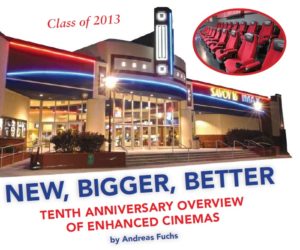 It’s hard to believe that ten years have passed since we presented our first “Class” overview in Film Journal International. Our surveys of each prior year to see how movie theatres around the world are evolving have introduced our readers to an inspiring group of graduates that is nothing short of amazing. Cinemas added bigger and better seats, some of them even moving in tune with the movie. Alongside the addition of footrests and tables and speakers galore, they made their screens extra-large and dimensionalized their sound systems for utmost clarity, separation and detail.
It’s hard to believe that ten years have passed since we presented our first “Class” overview in Film Journal International. Our surveys of each prior year to see how movie theatres around the world are evolving have introduced our readers to an inspiring group of graduates that is nothing short of amazing. Cinemas added bigger and better seats, some of them even moving in tune with the movie. Alongside the addition of footrests and tables and speakers galore, they made their screens extra-large and dimensionalized their sound systems for utmost clarity, separation and detail.
(Download the full PDF version of this article here)
Exhibitors brought beer and wine and delicious food into the auditorium mix as they expanded their offerings throughout increasingly spacious lobbies and at the concession counter, which has become a veritable Marketplace of options, to borrow from our friends at AMC Theatres (www.amctheatres.com/food-and-drink/marketplace). Cinema owners also learned concepts like VIP, luxury and extra amenities all around, designed and built with patron comfort and experience in mind. Where we once praised eefficiency and throughput in this industry, our school of thought has since turned towards pampering our patrons, inviting them to linger and lounge around longer. According to Mike Cummings, principal at TK Architects International (www.tkarch.com), “the last ten years in the cinema industry have been driven by two primary factors. e rst was consolidation and acquisition. If you want to see the impact, just look at the ‘Exhibition Guide’ from ten years ago and count how many chains were acquired by other companies.”
Thee second trend was technological in nature. “After 3D was the initial driver that helped push the industry forward, ”full digitization became the real driver of change. “It also led to the proliferation of large-format and premium auditorium experiences. e emerging business model…is now exploding, including large-format screens, opening weekend premiere auditoriums in formats you all recognize—IMAX, XD, RPX, DLX and others. ey also include luxurious auditoriums with premium seating and enhanced food and beverage options, all being provided by exhibitors in their theatres at current market ticket prices. Yes, a premium experience without a premium ticket price!” National Amusements provides a case for both (www.showcasecinemas.com).
In time for the summer season, the pioneers behind de-lux cinema development upped the VIP ante with Showcase SuperLux (http://bit.ly/´i0713superlux) before they launched “the highest-quality visual and audio entertainment available in theatres” in three of their Cinema de Lux locations on Nov. 7. Under the Showcase XPlus brand, guests in Edgewater, New Jersey, and of the Massachusetts cities of Revere and Worcester are now treated to “immersive and lifelike soundscapes” from up to 64 speakers, courtesy of Dolby Atmos. 3D white high-gain screens are lit up with RealD XL technology projected from Barco’s 33,000-lumen DP32B-4K projectors. Noted company president Shari Redstone, “e introduction of Showcase XPlus emphasizes our commitment to be at the forefront of the newest technology advancements in the theatre industry to provide the most enjoyable and enthralling viewing experience.” Calling XPlus “the future of entertainment,” Redstone is “con dent that our guests will be truly impressed with our efforts to continue to oer the very best experience one can have while watching a movie.”
In Omaha, Nebraska, the TK Architects-led major remodel of the former Douglas-to-Marcus theatres 20 Grand prompted the Omaha World Herald to call the result “Omaha’s most decadent movie theatre experience.” Transforming an early-1990s megaplex (http://cinematreasures.org/theatres/19690) into “an upscale boutique cinema experience” under the Marcus Majestic banner (unveiled in August), Cummings says, encompassed the conversion of 19 traditional auditoriums to VIP seating. “In the process, the seat count was reduced by 60% from 3,361 to 1,046,” he relays. “All theatres have DreamLounger electric recliners with added legroom in each row and patrons can reserve speci c seats in advance” without any upcharge. “For the new seating style, ticket ricing is the same as pre-renovation,” he assures. (You can hear more about that policy next month when we speak with Marcus CEO Rolando Rodriguez.) ree of the Majestic auditoriums oer in-theatre dining and an existing party room was converted into a Take Five Lounge. Majestic also offers updated concession areas and Zaro’s Express food options. Featuring self-serve drinks, soft-seating areas, large chandeliers and a baby grand piano, “the lobby is designed to entertain patrons.” Cummings names additional personal favorite features. “How the Take Five Lounge ows out into the space has completely transformed the notion of what a lobby should be. Namely, another amenity for the patron and an opportunity for the cinema to increase revenue. Thee overall look and feel is modern luxurywith Art Deco inuences.”
What’s up with the 20th Grand screen, though? “It never opened in the original plan as an auditorium, due to diculties with access. Instead, the space became an arcade that has now been converted into two conference rooms.” Cinemark Movie Bistro in Edinburg, Texas (opened August 2013 with six screens in 34,300 sq ft./3,190 sq. m.) is another result of a cinema in waiting. “This project was originally designed as a movie theatre in a strip shopping center, but was never opened” as originally planned for Alamo Drafthouse. Instead, Cummings continues, “Cinemark took the space and turned it into a 663-seat, all-VIP dining operation. Edinburg introduced Cinemark’s first-run cinema eatery concept branded Movie Bistro. The complex offers digital projection, RealD 3D capability, and enhanced sound systems to complement “an expanded menu with highquality food oerings” with “micro-brewed beers, premium wines, margaritas and fountain beverages.” Despite hitting upon “some unforeseen existing conditions,” TK and the construction crews delivered on “the biggest challenge of trying to keep the project on schedule,” Cummings confirms. “Our goal was to provide a functional and cost-efective project within the existing footprint. We also added a party room and office space to the original plan. The photos are very impressive and the recently opened cinema is expected to breathe new life into this commercial development district.”
Originally going back to RKO Stanley-Warner in 1966/67 (http://cinematreasures.org/theatres/3449), the December 2013 Regal Cinemas Stadium 12 & RPX in Moorestown, New Jersey (2,400 seats ranging from 129 to 366; 58,000 sq. ft., 5,390 sq. m.), has been breathing a lot of life into the community. “The main goal was to replace an old, rundown theatre with a new state-of-the-art venue which would bolster the newly revamped Moorestown Mall,” explains Paul Georges, principal at JKR Partners (www.jkrpartners.com). “We utilized a refined approach to the design and finish selections…to reflect the demographic. One goal was to create an exciting yet subtle backdrop to notes of excitement—those being the theatre entrances and concessions.
The best part of designing this theatre was also the most challenging,”he admits. “Fitting Regal’s requirements into the defined footprint was the tough part, but also the most satisfying when we were able to meet both their needs and the mall owners’ needs within a very aggressive schedule. The building area was established by the combined areas of the former UA Moorestown Mall 7 and an adjacent vacated indoor skate park within the mall. Both structures were demolished to make way for the construction of the new theatre.”
Although not that much was demolished at the Savoy 16 in the Illinois town of the same name (www.gqti.com/theaters.aspx?theaterid=1476), the remodel of the early-1990s Goodrich Quality eater is equally emblematic of expanding and up-scaling. “The theatre received an entire exterior makeover, including the addition of a new IMAX studio,” says Devon Carlson, marketing manager at Paradigm Design (www.paradigmae.com). “To create a vertical emphasis on a previously horizontal building, a new marquee was added and decorative pilasters were used on the corners of the building. Accents of bolder hues are used to highlight exterior elements, which were previously lost in the existing bland color scheme. The addition of LED lights helps create an even more inviting exterior.” On the inside as well, the Savoy went all out. “The renovation created an open environment and maximized theatre’s ability to serve customers more eff ciently. Relocating the concession stand and box office along with removing the existing drop ceiling changed the feeling from ‘cramped’ to ‘spacious.’” Carlson adds how three-dimensional formed materials — along with exciting paint schemes that replaced the previous neon look with more muted shades—helped “to bring back excitement and upscale atmosphere to the outdated interior. e addition of the IMAX eatre and D-Box seating creates a remarkable, multi-sensory experience for viewers,” Carlson feels. “The remainder of the studios was converted to stadium seating and received new furnishings, including reclining leather chairs. All told, the implemented changes created a cleaner and friendlier environment, giving Goodrich Quality theaters an edge.”
Carlson con rms that “Savoy 16 has seen a signi cant increase in sales and customer enjoyment.” Most impressively, perhaps, “the new addition along with both the interior and exterior renovations of the theatre was constructed while keeping the building operational and safe for the customers.” Make sure to attend next month’s “Class of 2013” session that will highlight development of entirely new cinema locations.



